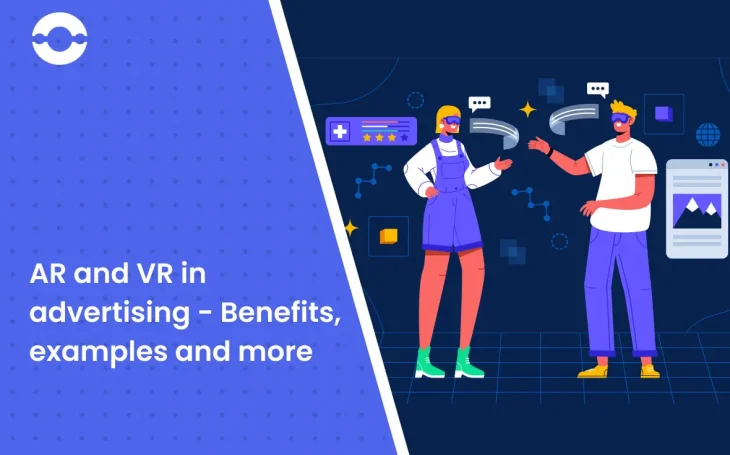
AR and VR are changing the world of advertising by providing a real-world experience of products to consumers.
AR/VR in advertising is an emerging tool for marketers as it offers immense potential for them to make ads more entertaining and engaging.
Brands that are leveraging these technologies create new possibilities for consumers by developing a personalized relationship with them.
As a result, it is a win-win for consumers and businesses as consumers get immersive experiences and brands can increase their conversions.
In this blog, we will study a lot about AR/VR in advertising, popular examples of brands, and why businesses should leverage these.
What is AR in advertising?
As the name suggests augmented means adding something to real-life settings.
Augmented reality allows the user to modify the real-world environment.
AR in advertising superimposes digital elements (images, animations, sound) in the real-world environment and provides innovative ways for advertisers to reach out to consumers.
These days brands are using AR advertising as an effective tool to enhance customer experience.
AR advertising makes traditional ads more interactive meaning users have become a part of such advertisements.
As per Zenith UK media, it would be wrong to count AR advertising as an emerging technology as it holds a promising future in the coming few years. It has now become mainstream technology for advertisers to provide memorable experiences for consumers.
An effective example of AR advertising is when a clothing brand allows a customer to virtually try on products before purchasing using their smartphones.
Because of changes in technology and consumer preferences, global spending on digital ads is going to increase from 626.86 billion in 2023 to 835.82 billion in 2028.
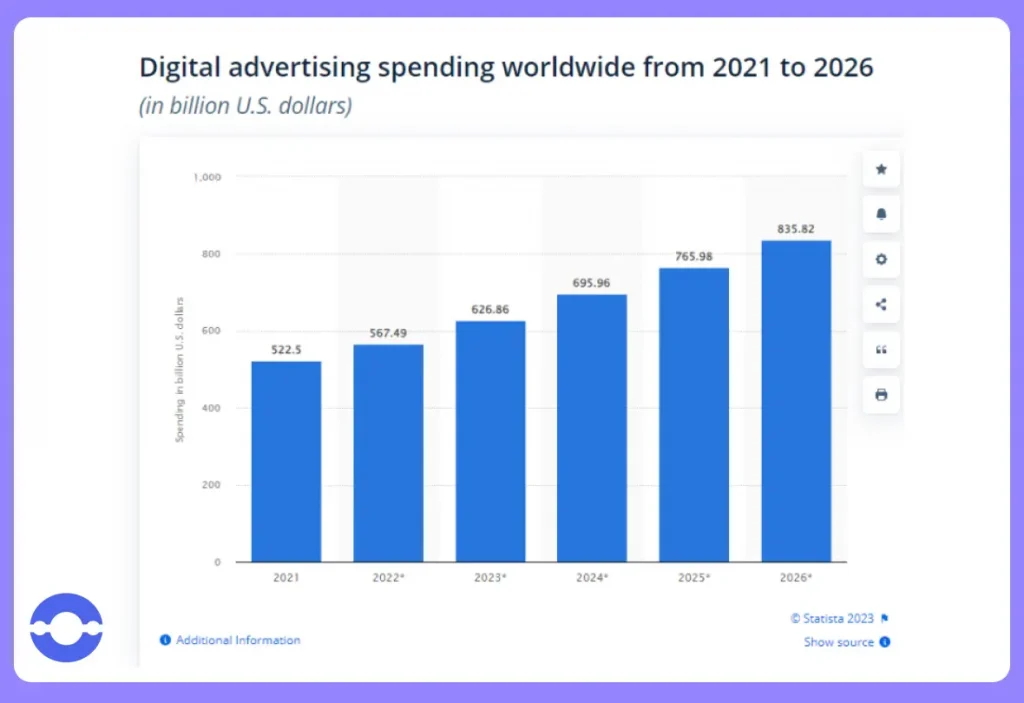
The above graph gives you insights into how digital advertising is growing and is expected to dominate the world.
So, it’s the right time for you to leverage this hottest technology trend to meet customer demands, capture their attention, and drive more sales.
Benefits of adopting AR advertising for brands
Here are a few reasons why brands should invest in AR advertising-
1. Increases customer engagement
With AR advertising, you are more likely to gauge your customers’ attention as it provides an immersive experience for customers to interact with products.
Results from the 2021 survey state that 61% of mobile app users felt that AR ads are more impactful than traditional 2D ads.
Consumers who are exposed to AR love AR because they can feel and try the products virtually which makes it more entertaining for them.
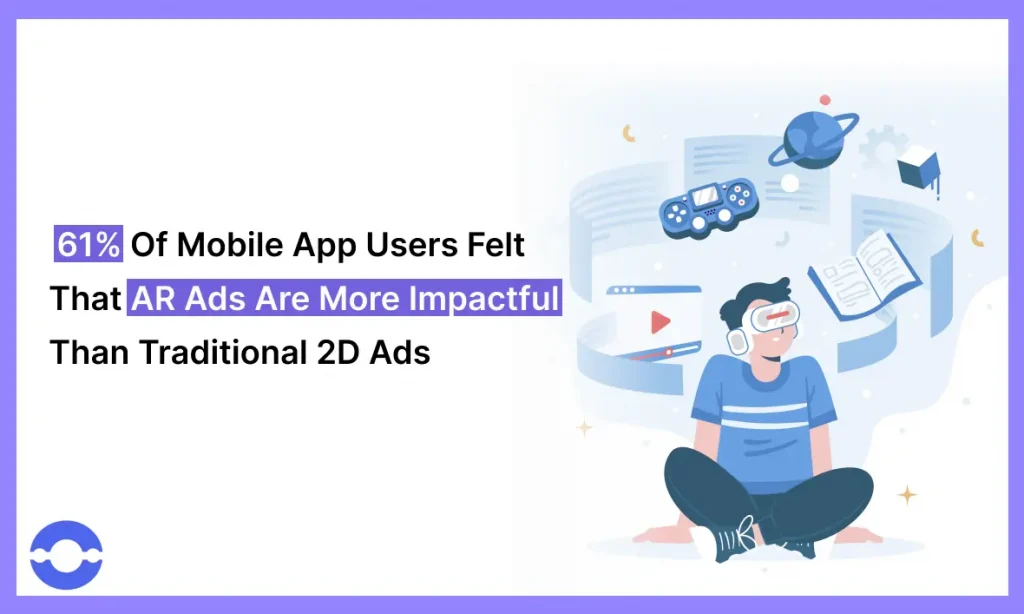
By interacting with 3D products, customers get to learn more about the product.
When customers spend more time interacting with 3D products, businesses can expect more sales and revenue.
For Instance – If you are running a makeup brand, customers can get a virtual try-on makeup experience to see how the makeup looks on their face. This makes it easier for brands to take their marketing campaigns to the next level.
2. Builds brand awareness
Using AR advertising, businesses can generate a buzz about their products/services.
AR in advertising turns those boring ads into rich and interactive experiences. Several research studies found that customers are 5x more likely to buy from brands that they recognize.
When businesses add AR to their campaigns, it not only increases brand awareness but also lowers their cost by 59%.
For Instance – Nike tried to promote their AR sneakers by providing an AR experience to customers. Once users point their phone towards the sky, they would see sneakers shaped like a cloud.
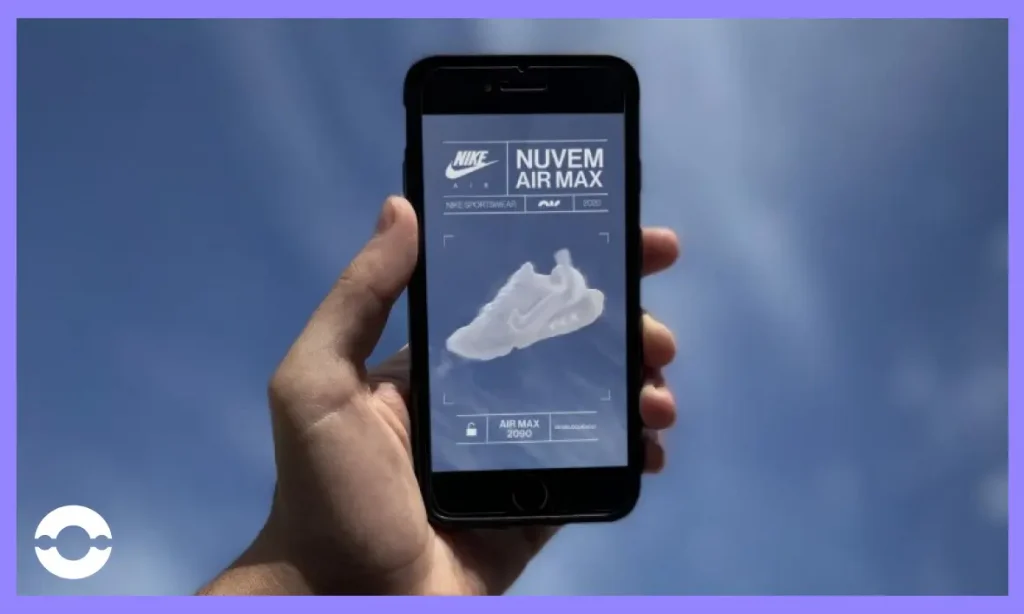
Because of this AR campaign, the company was able to drive 22% more visitors to its website. This is how Nike builds brand awareness by running an AR ad.
3. Drive more conversions
Companies that run AR ad campaigns experience 94% conversion rates than those who are rolling out traditional ads.
With AR ads, consumers get more confident while purchasing as they can get detailed product information while interacting with a product.
Also, AR campaigns allow customers to use virtual try-on features which leads to a reduction in product returns.
Companies such as Adidas and Macy’s provided virtual fitting rooms to customers so that they could try dresses before purchasing them. Consequently, their product return rates were reduced by 36%.
An exciting example of this is Toys “R” US Canada ran an AR campaign by partnering with Snapchat to bring their toys and products to real life.
With Snapchat portal lens technology, users were directed to virtual stores where they could buy their favorite toys and bring them down the funnel.
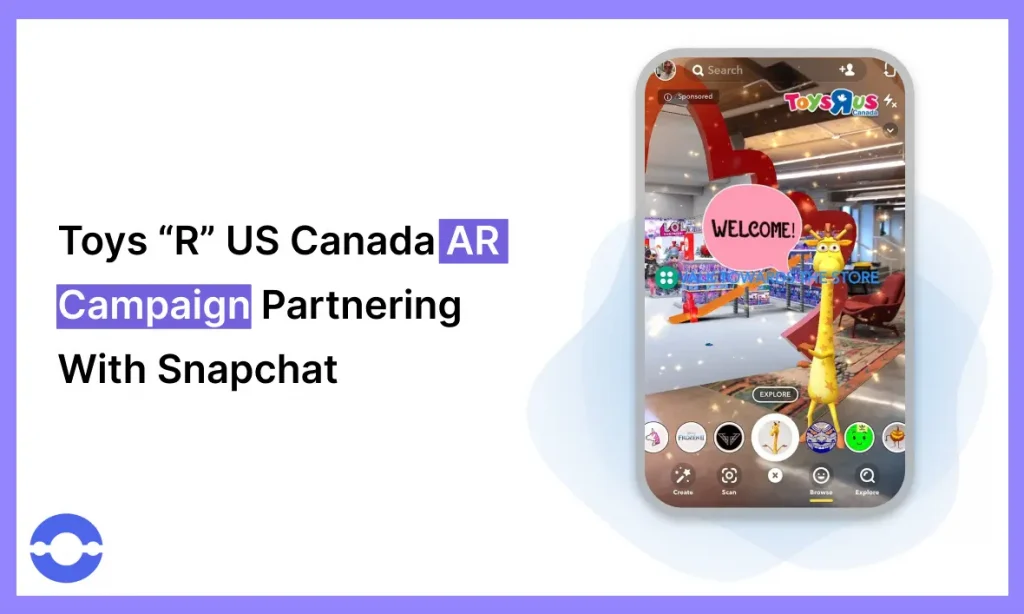
4. Maximize your sales
AR ads aren’t just mere means of heavily promoting your products/services.
Rather, it offers more innovative ways for consumers to interact with a product whether it is trying clothes virtually or playing games.
Imagine yourself when you come across an ad for sunglasses, and you want to buy them.
You aren’t sure whether they will suit you or not. That’s why augmented reality in advertising is used to help you choose the best fit for you from the collections.
Pepsi Max, for instance, used an AR advertising campaign by turning the bus shelter wall into a fake window.
The company created an illusion where robots were attacking down the street and buses were flying over people’s heads. People started enjoying it as they had to wait for buses and Pepsi brought new surprises to capture the people’s attention on the street.
With this AR campaign, their beverage sales increased by up to 30% within the first 2 months by bringing virtual objects into the physical world.
Also Read: AR VR in Aerospace and it’s Benefits for Aviation Industry
What is VR in advertising?
Virtual reality advertising allows brands to advertise their products using VR technology in a virtual world.
Such technology offers immense potential for brands to interact with their customers and develop close relationships.
Brands are more inclined towards creating immersive advertisements to provide memorable experiences to customers.
VR ads can take different forms such as in-game advertisements, interactive VR experiences, and 360-degree ads.
Under VR advertising, users are transported to a new virtual space where they can interact with the objects.
By immersing users in the 3D environment, marketers get more possibilities to connect with consumers and better communicate their message to the target customers.
So, why run those boring display advertisements to push your products every time?
Because VR is going to transform the way by displaying your products differently, so you can play with the space around them.
Benefits of adopting VR advertising for brands
Virtual reality technology was earlier used in various fields such as engineering, tourism, construction, and education. Now advertising is not an exception.
While VR ads require a great investment from your side, they will provide you with higher marketing ROI in the long term.
Popular examples of VR in advertising
1. IKEA
IKEA India came up with a guerilla marketing campaign so they can attract more customers to visit their store.
People who are traveling daily can take a virtual tour of IKEA by wearing VR headsets that are already installed inside hired autos in Hyderabad.
The goal of running this VR campaign was to excite users to bring furniture to their homes by making it live on the streets.
2. Oreo
Oreo takes you to the world of Wonder Vault aka a virtual world where you can explore a 360-degree experience of new cupcake-filled Oreos.
Using Google’s cardboard headset, viewers can explore cocoa mountains and milk rivers.
The goal behind running such a VR ad is to sip the chocolate river and taste every bite of Oreo so that you will feel hungrier.
Here are the benefits of why brands should leverage VR advertising
1. Engages your customers
In this hyper-competitive market, the attention span of consumers is decreasing day by day and consumers want less intrusive ads because they are irrelevant for them.
The only alternative left for marketers is to run AR/VR ads where consumers get absorbed in that brand communication.
Undoubtedly, VR advertisements outperform traditional 2D ads because these are not just mere advertisements, rather they allow customers to experience your products/services on a more personal level.
However, such personalized experiences are not possible in traditional marketing methods.
2. Convinces your customer to make a purchase
With traditional ads, it is challenging for brands to convince customers because they can’t feel your products.
When they are exposed to VR ads, they feel confident about purchasing as they can virtually try products.
Volvo, for instance, came up with a VR test drive allowing customers to drive the car as if they were driving the car on the road.
Once they are satisfied with the virtual test drive, they can move on to the final stage of making a purchase.
3. Introduces new products in the market
Virtual reality is important for advertisers as it takes your product game to the next level.
It goes beyond traditional visuals or descriptions and creates a lasting impression in the customer’s mind.
With VR ads, it becomes easier for brands to win the trust of customers as those virtual experiences let customers fall in love with your brand.
Patron for instance leverages virtual reality to advertise its product called Tequila (an alcoholic product).

With the help of virtual reality, customers can explore the production process in a 360-degree view. The company believes that customers should know about the origin of products.
4. Smoothens your customer journey
Virtual reality provides new experiences to customers as they can interact with the product or service.
Customers can go back to past times and join new adventures all using their smartphones. VR makes it possible for them to truly experience your products.
National Geographic Explore VR for instance takes your audience to the next level. Players can explore the areas of Antarctica and Machu Picchu. They can get those immersive experiences without coming out of their comfort zone.
5. Increases your conversion rates
When you add a video to a landing page, it shoots your conversion rates.
Similarly, adding VR to your marketing campaigns will skyrocket your conversion rates, which you can’t expect with traditional advertising mediums.
Research studies indicate that customers are 58% more likely to buy those products they can try out because VR experiences establish a deeper connection with customers.
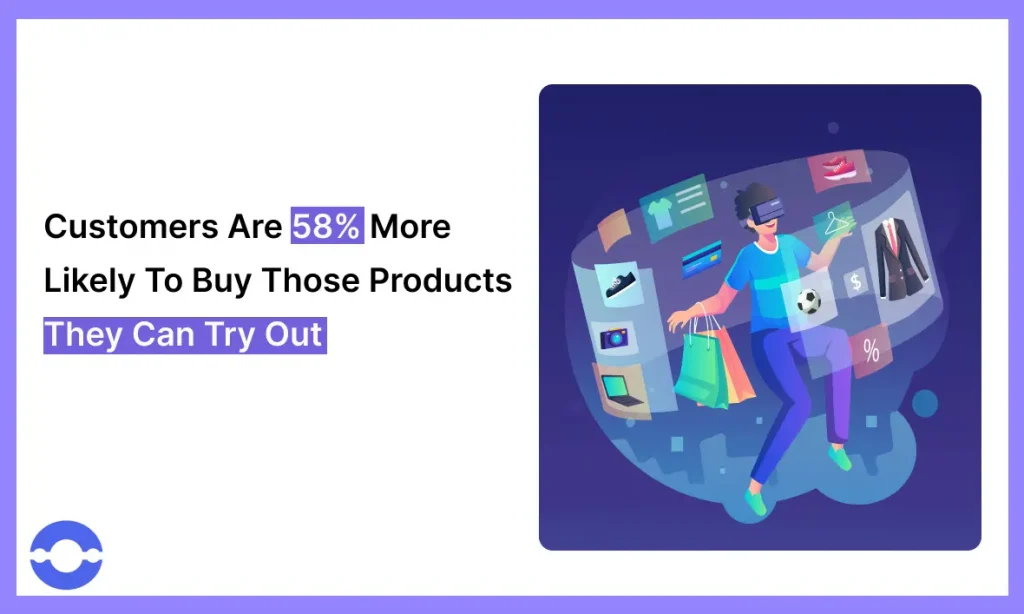
6. Access to data-driven insights
Brands can get valuable insights by implementing VR in their advertising strategies.
They can track what users are doing, how much time they are spending, and how they are interacting in the virtual world.
With such insights, brands can understand consumer behavior and optimize their campaigns accordingly to get optimal results.
AR and VR in advertising help advertisers to capture customers’ attention and increase their business sales.
Must Read: AR And VR In The Retail Industry
Wrapping up
Businesses can stay ahead of the curve by leveraging virtual reality and augmented reality to create new experiences for customers.
Luxury brands such as IKEA, Volvo, etc. are already using AR/VR to make their ads more engaging and interactive.
You might have observed that people including you intend to skip ads while streaming videos. Undoubtedly, people can’t pay attention to a 2-minute ad.
That’s where brands should leverage AR/VR to bring their customers into a virtual world.
When other brands are taking full advantage of this technology, why not you?
You need to make AR/VR a part of your marketing strategy so that you can connect with your customers and build closer relationships with them.
So, why take the whole burden on your shoulders when our dedicated team of experts is there to develop AR/VR apps and level up your marketing game?
At BigOhTech, we provide cost-effective AR/VR development solutions that provide a satisfying experience for your customers.




